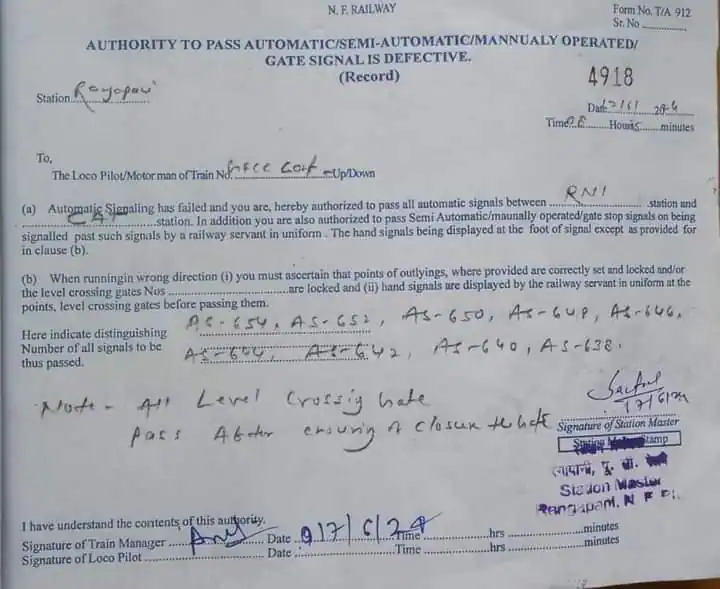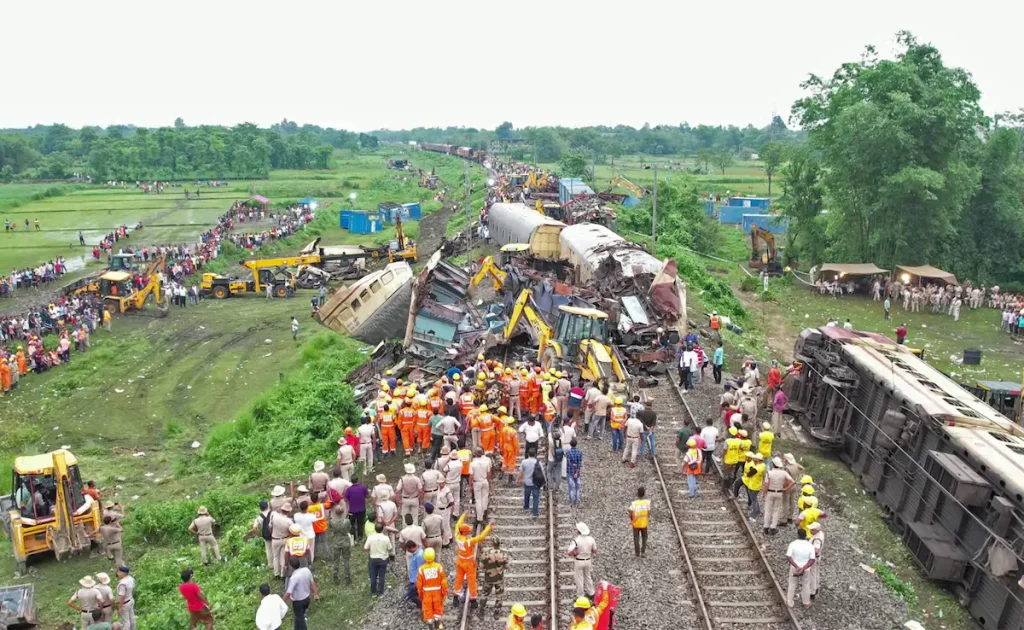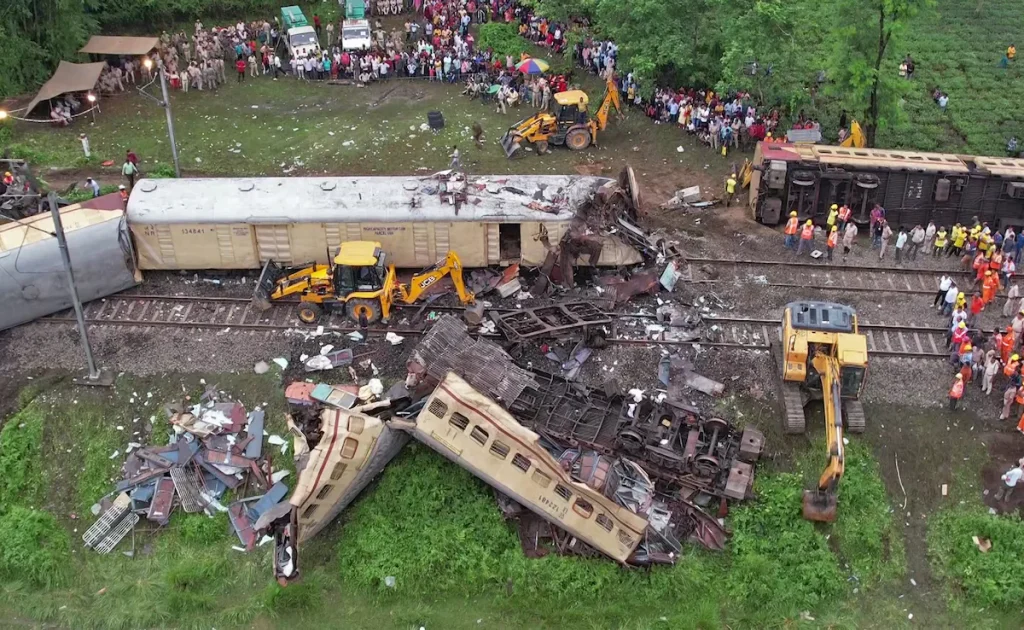Kolkata: A tragic incident occurred near Rangapani station, close to New Jalpaiguri, on Monday morning when the Kanchanjunga Express, traveling from Agartala in Tripura to Sealdah in Kolkata, was struck from behind by a goods train. This unfortunate collision resulted in the loss of nine lives and left 41 individuals injured. Initial investigations suggest that a combination of human error and signal failure played a role in this devastating accident.

According to the Railway Board’s preliminary report, the goods train was operating under a faulty automatic signaling system and was traveling at a speed exceeding the prescribed limits when it collided with the Kanchanjunga Express. The railways have not yet provided any official statement regarding this matter.
In situations where the automated system malfunctions, railway protocol dictates the use of a written authorization called TA 912. This document grants train drivers permission to pass through red signals due to signaling defects, as long as they strictly adhere to stringent safety measures. Both the Kanchanjunga Express and the goods train had been issued TA 912, as depicted in the image below.
As per railway regulations, in accordance with TA 912, operators are required to come to a halt for one minute at any malfunctioning signal and continue at a top speed of 10 kmph. Furthermore, they are obligated to keep a distance of 150 meters from the train ahead to guarantee sufficient braking distance in case the preceding train has not passed the signal. Nevertheless, in this particular case, the driver of the freight train disregarded these crucial guidelines. The Kanchanjunga Express had successfully passed nine automated signals following TA 912 and had come to a stop after passing the ninth signal, waiting for a new signal to proceed.
Authorisation To Cross Red Signals
The Railway Board has stated that the driver of the goods train was granted permission to disregard all red signals between Rangapani and Chattarhat railway stations due to the faulty automatic signalling system. Nevertheless, the train’s speed surpassed the allowable limit designated for such circumstances. The station master of Rangapani issued a TA 912 to the goods train driver, authorizing the passage through nine red signals. This authorization was of utmost importance as the automatic signalling system had been experiencing malfunctions since 5:50 am on the day of the incident.

The GFCJ goods train departed from Rangapani at 8:42 am and collided with the stationary Kanchanjunga Express at 8:55 am, resulting in the derailment of several coaches. Among the casualties was the driver of the goods train, who failed to comply with the mandatory speed restrictions, ultimately causing the crash.
On the other hand, the driver of the Kanchanjunga Express followed all safety protocols in the presence of a signalling defect. He diligently stopped at every red signal for one minute and proceeded at a speed of 10 kmph. In stark contrast, the driver of the goods train exceeded the permissible limits and forcefully collided with the passenger train.
Failure of the Automatic Signalling System.

The authority letter TA 912 stated that the automatic signalling system had malfunctioned, allowing the driver to proceed past all automatic signals between Rangapani and Chattarhat, regardless of their color. The Railway Board specified that in normal circumstances, a train must halt for one minute during the day and two minutes at night upon encountering a red signal, proceeding cautiously at a speed not exceeding 15 kmph in good visibility and 10 kmph in poor visibility conditions. Despite these guidelines, the goods train exceeded the permitted speed, resulting in a severe collision. The Railway Board did not disclose the exact speed at which the goods train was traveling.
Rescue operations were completed by late afternoon, but efforts to clear the derailed coaches and restore rail services were ongoing. Several injured passengers were treated at North Bengal Medical College and Hospital, with 41 individuals still hospitalized, including nine in critical condition.
Official Response
The accident is currently being investigated by the Commissioner of Railway Safety (CRS). Railway Minister Ashwini Vaishnaw personally visited the location to oversee relief efforts and announced compensation for the families of the victims. The families of the deceased will receive ₹ 10 lakh, while those who were severely injured will receive ₹ 2.5 lakh, and those with minor injuries will receive ₹ 50,000.
Prime Minister Narendra Modi expressed his condolences to the victims and offered prayers for the speedy recovery of the injured. In a post on X, PM Modi stated, “The railway accident in West Bengal is a tragic event. My heartfelt condolences to those who have lost their loved ones. I pray for the swift recovery of the injured. I have also spoken to officials and assessed the situation. Rescue operations are currently underway to assist those affected. Railway Minister Shri @AshwiniVaishnaw Ji is also en route to the accident site.”
West Bengal Chief Minister Mamata Banerjee condemned the Railway Ministry for its negligence towards passenger safety and its ineffective implementation of the anti-collision system. She criticized the focus on fare hikes over improving safety measures, stating that the railways have lost their former glory and are neglecting passenger amenities. Mamata Banerjee expressed solidarity with railway employees and officers, highlighting the lack of attention towards their well-being. Governor CV Ananda Bose emphasized the importance of prioritizing the treatment of victims over engaging in blame games.

